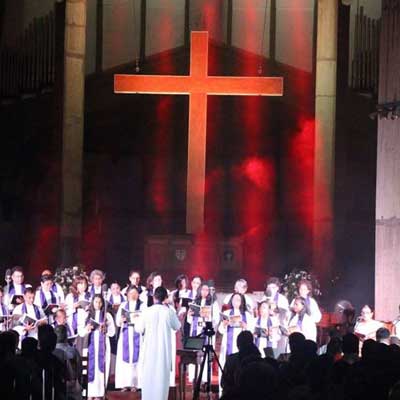Easter music that moves them most

When I survey the Wondrous Cross: Ishan de Lanerolle conducting the choir of the Cathedral of Christ the Living Saviour in 2023
Music in all its diverse forms is an integral part of Christian worship and has been from Old Testament times. While we all have our favourite Christmas tunes whether we celebrate the birth of Jesus or not, Passiontide and Easter music are hardly experienced outside of a church setting. As Christians around the globe celebrate salvation through the resurrection of Jesus Christ today, the Sunday Times spoke to some well-known musicians to learn of their favourite music that accompanied this Good Friday and Easter Sunday.
Multi-talented musician and composer Rukshan Perera performed many of the songs from the musical Jesus Christ Superstar in the 1970’s with Clarence Wijewardena and the Super Golden Chimes, and it is this landmark work by Sir Andrew Lloyd Webber and Tim Rice that he connects with when speaking of Passiontide and Easter.
“They’re not hymns, they’re pop songs,” Rukshan hesitates, noting also the controversy around the work, and religious criticism it has received. “Some people don’t like the show… but people who could doubt the creativity? I was 18 or 19 when it debuted and I truly appreciated it as a musician and composer,” Rukshan says.
For him, it is on the one hand important to remember that the work is a creation – nevertheless he also feels that in its entirety, the work “depicts well, what Jesus went through.” He notes particularly the song “Gethsemane” which Jesus sings in his moment of doubt about going through with his death and crucifixion.
Rukshan’s favourite song though is “Heaven on Their Minds” the very first after the Overture to the musical, sung by Judas. “The lyrics, the way he sings, the way he expresses” all inspire Rukshan as well as the importance of the message. “He is questioning Jesus ‘why are you doing this?’ These are questions that a lot of people may have had at a time, including his disciples.”
Director of the Colombo Philharmonic Choir, Harin Amirthanathan first performed the St. John Passion, BWV 245 under the baton of Gregory Rose in 2015 and has made a ritual since, of listening to it on Good Friday every year. “What an opening!” Harin enthuses, “Herr, unser Herrscher, dessen Ruhm in allen Landen herrlich ist! (Lord, our ruler, whose praise is glorious in all lands) gives me the chills every time…” The dramatic urgency of the work, the sharp contrast and vivid depictions of the Passion story create a “gripping sense of immediacy” Harin continues, adding that Bach crafted the work not just as a concert piece but as a form of worship. “For many this elevates the work beyond music into a sacred experience… offering deep reflection making it spiritually and musically transformative.”
“The journey towards Easter is very important, universally,” says Ramya de Livera Perera, musician and educator. And this is best captured for her in ‘Adagio for Strings’, the second movement of Samuel Barber’s String Quartet, Op. 11. Ramya draws a parallel between the historical context in which Barber lived (between two world wars and through the Great Depression), the difficulties of human life on earth, and the suffering Jesus endured from the garden at Gethsemane to the cross at Calvary and the tomb. “(Barber) would have undergone so much to be able to compose something like this, it is truly a masterpiece,” she says.
In this iconic work which has been used in multiple films and is often played at funerals, the entire orchestra moves with difficulty and jarring harmonies through a mournful melody that neverthess moves upwards and holds the orchestra very much together. “It really hurts when you hear those dissonances,” Ramya says, but as she points out, the “beautiful ascending tone” gives the piece depth and complexity. “It gives you that feeling of hopelessness, but also the feeling that you are transcending, that there is hope, there is hope. It is a journey. You are not living in the hopelessness… For me, that journey towards Easter is the most important part.”
‘The Seven Last Words of Our Saviour on the Cross’ by Franz Joseph Haydn and ‘Lament of the Mother of God,’ by John Tavener are musician and composer Lakshman Joseph De Saram’s choice of music to accompany that journey to Easter Sunday. The first piece, which he describes as “very special music” is a series of meditations on the seven final statements uttered by Jesus on the Cross, arranged for string quartet, orchestra and voices. The second, written for Soprano solo and 12-part chorus is a haunting rendition of part of the Orthodox sung tradition for Holy Week and Good Friday. The unspeakable pain of Mary, mother of Jesus, watching her child crucified and dying and the deep unshakable faith she rests on the God who gave her the same child is recreated with a repeated ‘Woe is me, my Child’ sung in an “iron-like stillness and great purity” which the composer requires of the soloist. “It moves me each time I listen to it,” Lakshman says simply.
Yet at the end of that deeply painful Holy Week comes the resurrection on Easter Sunday, and the joy of salvation through the risen Christ. Lakshman chooses the triumphant exultation of the chorus ‘Kommt, eilet und laufet’ from J. S. Bach’s Easter Oratorio, BWV 249. While the work is not as well-known as the St. Matthew Passion and St. John Passion it is “a masterpiece in its own right,” he says. “Come, hurry and run you fleet feet,” the chorus sings in a fast-moving jubilation over a flowing full orchestra, calling all to the tomb to see that “our salvation is risen!”
Ishan De Lanerolle, of the De Lanerolle Brothers and the Music Ministry Choir says that one of his “absolute favourite” hymns is ‘There Is A Green Hill Far Away’ written by Cecil Frances Alexander and set to music by George Coles Stebbins. “It’s the lyrics that strike a profound chord,” Ishan says. ‘There is a green hill far away, without a city wall,’ the hymn begins, and for Ishan this first line carries the depth and breadth of the reason Christ was born, killed and raised from the dead. “The word ‘green’ evokes imagery of life, hope and renewal quite the opposite of the barren, brown reality of the hill on which Christ was crucified,” he says, adding that it symbolizes that “there is still life, even in the place of death”.
The second part of that line, he describes as “powerful”. “It reminds us that Jesus’ sacrifice was not confined or exclusive. It was open to everyone, not limited by boundaries, social classes, or beliefs… In times like these where the world feels divided and uncertain, I find even more meaning in hymns like There Is A Green Hill Far Away. Its message of open invitation, love beyond boundaries, and hope through sacrifice is something we all need to be reminded of.”
This message is particularly relevant to Ishan who says that “music has been a powerful vehicle to deepen my own faith and to help others encounter something sacred”. Ishan works with Neranjan de Silva through the Music Ministry Choir to “share the message of love, grace and hope without restrictions”. And in the same way that the hymn speaks of a hill without a wall, their music ministry “strives to reach hearts regardless of denomination or background”.
Searching for an ideal partner? Find your soul mate on Hitad.lk, Sri Lanka's favourite marriage proposals page. With Hitad.lk matrimonial advertisements you have access to thousands of ads from potential suitors who are looking for someone just like you.


